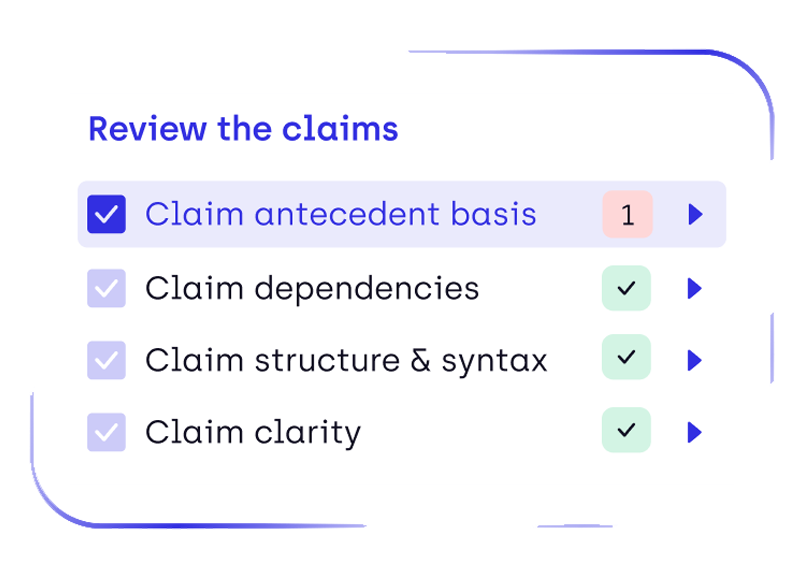Improving Patent Applications Quality: A Guide for Law Firms
In today’s fast-paced legal environment, ensuring high-quality patent applications while managing multiple tasks can be challenging. This use case provides a practical example of how AI, specifically DeepIP's Patent Assistant, helps law firms enhance the quality of their work.
Improving Patent Applications with AI: A Guide for Law Firms
Explore how Wood IP improved its patent drafting and review processes using AI, and understand how this technology can significantly elevate the quality of your patent applications.

Context: Delivering the highest quality for clients
As Theodore Wood, a partner at Wood IP, explains, “Patent quality is the number one priority at our firm, and with limited bandwidth, patent practitioners must balance several tasks at once, from drafting applications to ensuring they are precise and error-free. It can be a juggling act sometimes which demands a smarter way to operate.”
Solution: DeepIP’s AI-Powered Patent Assistant
For Wood IP, the goal was to improve the quality of each draft application by maximizing the time practitioners spend on this high-value task.
DeepIP’s AI Assistant is here to handle the repetitive, time-consuming tasks so the practitioner can focus on what matters—creating a higher-quality patent application.
Here are two practical examples:
1. Drafting the detailed description
Drafting a detailed description section of the patent application can often take time. With DeepIP, the team can quickly generate a baseline for the detailed description using data input into the tool, which can then be expanded upon to ensure it aligns accurately with the inventor's figures. This tool allows the practitioner to focus on the more substantive details of the invention such as claims, subject matter eligibility, and novelty, to enhance the quality and the value of the application and subsequent issued patent.
DeepIP also provides highly accurate basic descriptions of the drawings by capturing reference numbers and elements/steps from block diagrams and flow charts input into the tool. It will also use claims drafted by the practitioner and leverage contextual documents provided, to enhance the detailed description and provide support for the claims.

2. Reviewing the patent
Patent applications are complex documents, often requiring meticulous attention to detail in both the content and formatting. Before adopting DeepIP, much of this work had to be done manually, including:
- Ensuring consistency between reference characters and figures.
- Cross-checking claims for accuracy against the invention descriptions.
- Reviewing lengthy documents for minor, yet time-consuming errors.
For instance, instead of manually verifying the accuracy of references between patent drawings and descriptions, DeepIP automates this process, reducing the risk of human error while ensuring attention to detail. This allows the attorneys to spend more time on complex legal analysis, ultimately improving the quality of the final product. By streamlining routine tasks with DeepIP and prioritizing high-value work, Wood IP consistently ensures top-quality patent applications for its clients, all without raising costs.

Why DeepIP?

1. Intuitive User Experience
DeepIP’s ease of use was a crucial factor in Wood IP's decision to adopt the tool. Its intuitive interface required minimal training, and practitioners could quickly incorporate it into their workflows without disruption.
2. High-Quality Output
With automated checks and detailed prompts, DeepIP ensures high-quality output with fewer errors and more consistent formatting across applications.
3. Control and Security
DeepIP acts as a co-pilot rather than a replacement, providing suggestions and automating repetitive tasks without sacrificing the firm’s oversight and expertise.
“We remain in control of client data, which is key for us and for our clients. AI helps us work smarter, but it doesn’t take over the process,” explains Ted Wood.
The security of client data is a priority. DeepIP’s stringent data security and confidentiality measures ensure that WoodIP’s client data remains secure when utilizing the AI Assistant:
- Strict separation between firm data, ensuring it remains isolated from other firms.
- No data is retained or reused for training purposes.
- All data is fully encrypted
{{block-cta}}
Conclusion
At Wood IP, the integration of AI through DeepIP has enhanced the firm's ability to deliver high-quality patent applications. By automating routine and time-consuming tasks, the firm ensures a more efficient and accurate process while maintaining the highest legal standards.
Key benefits for DeepIP’s users include:
- Improved Quality: With AI handling repetitive tasks, practitioners can focus on refining critical elements like patent claims and ensuring compliance with patent eligibility, resulting in higher-quality applications.
- Cost Efficiency: By streamlining workflows, Wood IP delivers top-tier results without increasing costs, making them a cost-effective choice for performing high-value patent prosecution.
- Consistency and Accuracy: DeepIP automates consistency checks, ensuring that details such as reference characters and figures are error-free, reducing the risk of human error.
For clients, choosing a firm like Wood IP means benefiting from the latest AI advancements while knowing that their patent work is handled by seasoned professionals. In today’s legal landscape, firms that leverage technology are better positioned to provide efficient, accurate, and cost-effective services—qualities that clients should prioritize when selecting a partner for their patent needs.
Discover how DeepIP can help you enhance the quality of your clients' patent applications—try it today and experience the difference for yourself.

.png)

.png)




